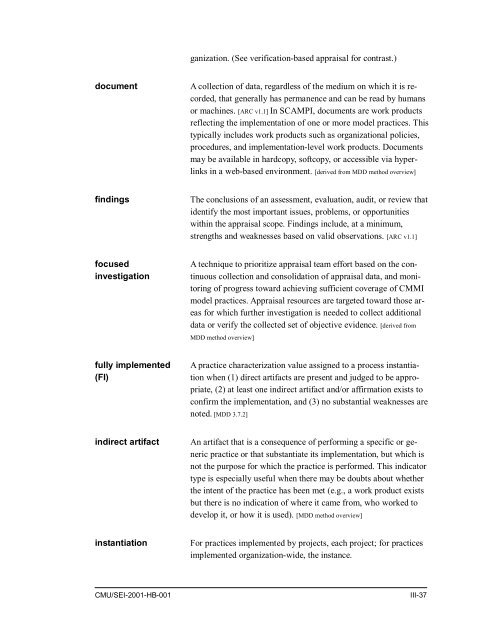Standard CMMI Appraisal Method for Process Improvement (SCAMPI)
Standard CMMI Appraisal Method for Process Improvement (SCAMPI)
Standard CMMI Appraisal Method for Process Improvement (SCAMPI)
You also want an ePaper? Increase the reach of your titles
YUMPU automatically turns print PDFs into web optimized ePapers that Google loves.
ganization. (See verification-based appraisal <strong>for</strong> contrast.)<br />
document<br />
A collection of data, regardless of the medium on which it is recorded,<br />
that generally has permanence and can be read by humans<br />
or machines. [ARC v1.1] In <strong>SCAMPI</strong>, documents are work products<br />
reflecting the implementation of one or more model practices. This<br />
typically includes work products such as organizational policies,<br />
procedures, and implementation-level work products. Documents<br />
may be available in hardcopy, softcopy, or accessible via hyperlinks<br />
in a web-based environment. [derived from MDD method overview]<br />
findings<br />
The conclusions of an assessment, evaluation, audit, or review that<br />
identify the most important issues, problems, or opportunities<br />
within the appraisal scope. Findings include, at a minimum,<br />
strengths and weaknesses based on valid observations. [ARC v1.1]<br />
focused<br />
investigation<br />
A technique to prioritize appraisal team ef<strong>for</strong>t based on the continuous<br />
collection and consolidation of appraisal data, and monitoring<br />
of progress toward achieving sufficient coverage of <strong>CMMI</strong><br />
model practices. <strong>Appraisal</strong> resources are targeted toward those areas<br />
<strong>for</strong> which further investigation is needed to collect additional<br />
data or verify the collected set of objective evidence. [derived from<br />
MDD method overview]<br />
fully implemented<br />
(FI)<br />
A practice characterization value assigned to a process instantiation<br />
when (1) direct artifacts are present and judged to be appropriate,<br />
(2) at least one indirect artifact and/or affirmation exists to<br />
confirm the implementation, and (3) no substantial weaknesses are<br />
noted. [MDD 3.7.2]<br />
indirect artifact<br />
An artifact that is a consequence of per<strong>for</strong>ming a specific or generic<br />
practice or that substantiate its implementation, but which is<br />
not the purpose <strong>for</strong> which the practice is per<strong>for</strong>med. This indicator<br />
type is especially useful when there may be doubts about whether<br />
the intent of the practice has been met (e.g., a work product exists<br />
but there is no indication of where it came from, who worked to<br />
develop it, or how it is used). [MDD method overview]<br />
instantiation<br />
For practices implemented by projects, each project; <strong>for</strong> practices<br />
implemented organization-wide, the instance.<br />
CMU/SEI-2001-HB-001<br />
III-37
















